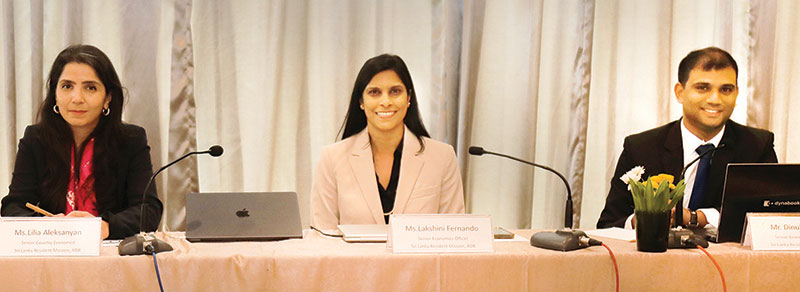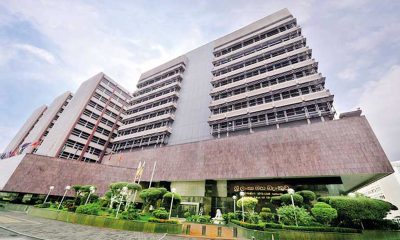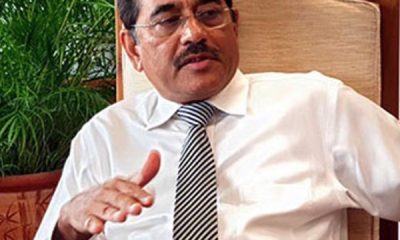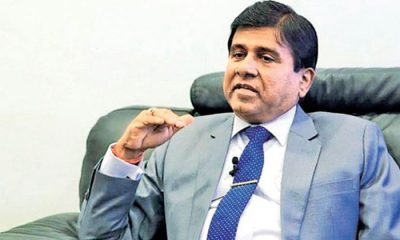Business
Central Bank sets its macroeconomic projections in a firm direction

But warns of uncertainty surrounding forecasts of given variables
by Sanath Nanayakkare
After the Central Bank of Sri Lanka (CBSL) recently set a more inclusive and predictable Monetary Policy under the new CBSL Act, the business community appears to be taking their cue from the Bank’s medium term economic projections as was evident by the increased buying interest at the Colombo Stock Exchange when the market opened trading for the week on August 7.
On August 3, Dr. P. K. G. Harischandra, Director of Economic Research at the Central Bank of Sri Lanka said that CBSL’s latest Monetary Policy Report would give guidance to financial markets and other stakeholders as to how inflation and price stability would behave in the medium term (next 2-3 years), and therefore, they could assess future trends in the economy while evaluating the matrix of downside risks and upside risks in their investment and business decisions.
“Anchoring inflation expectations is a key element in the Monetary Policy framework. We will be focusing on the need to stabilize inflation expectations in businesses and households alike,” he said on 3rd August addressing journalists at a technical discussion on the Monetary Policy Report.
Illustrating Inflation fan charts for the medium term, Dr. Harischandra said,”CBSL arrives at macroeconomic projections including that of inflation, using a semi-structural macroeconomic model. These projections are usually updated on a quarterly frequency along with the release of GDP data. Projections are arrived at using released data, projections of major global indicators, near-term forecasts of selected variables and judgments,” he said.
However, he pointed out that forecasts are uncertain by nature, which is represented by the confidence intervals, and this uncertainty needs to be taken into consideration when such forecasts are used for various purposes.
“As per latest projections, inflation is expected to reach single digit levels in Q3 2023, and will stabilize at the desired levels over the medium term. So, when inflation stabilizes over the medium term, interest rates also will move in line with it. A major element here is the risk factors on the forecasts. Sometimes the actual figures could differ from the baseline forecasts. We explain such risks in the Monetary Policy report, he said.
Dr. Harischandra noted that CBSL would build up credibility of the projections process through increased communication with the public ensuring a high level of transparency.
“Going forward, we will be publishing a forecast and when we receive actual data in the coming weeks and months, we will be able to see the difference between our forecasts and actual data. Yes, there may be some difference as our projections may not be 100% accurate. We will then explain why any such deviations from the forecasts have happened. And then we can refer to what adjustments are needed on the medium term forecasts for the benefit of the public and businesses. Through this process, we are committed to increasing the transparency and credibility of the Monetary Policy and our projections. Because when we commit ourselves to a medium term target, we have an accountability to achieve it. That is a requirement of the Monetary Policy.”
Speaking further Dr. Harischandra said, “In addition to maintaining price stability, there will be other policy coordination, and we will be creating a platform for discussions in order to support decision making in broader terms”
“In June 2023, Colombo Consumer Price Index (CCPI) was 12%. In July it came down to 6.3%. The core inflation declined to 6.1%. Within this month, we expect that it will come into the targeted range. When headline inflation came down to 6.3%, food inflation became a negative 1.4%. Non-food has gone up by 19.5%, but transportation is a negative 9.3%. These reasons, prudent policies on the fiscal front and the inflation base effect in 2022 mainly brought inflation down. People ask if inflation has decelerated why prices aren’t coming down. We say at every forum that a fall in inflation is not necessarily about a fall in prices of all commodities across the board. Prices of some consumer items have declined notably giving relief to the consumers and prices of some other items have slowed the rate of increase in prices. Overall, there are no price shocks now. Journalists also have a task in communicating this properly to the public because it is a huge incomprehension that a fall in inflation is a fall in prices of everything.”
“Each economy needs some inflation. If there is negative inflation nobody will invest and produce because if prices keep coming down there will be losses. So, no country targets negative inflation. But as we came from a very high inflation to lower inflation, there was some negative inflation. A good rule of thumb for any country is not to let the price of the overall basket to get negative inflation because the consequences of that could ripple through the economy.”
Dr. Harishchandra told The Island Financial Review that the exchange rate of the US dollar to LKR won’t see much of an adverse effect when the government begins to make foreign debt repayments because the Domestic Debt Optimization programme is designed to withstand such risk.
Business
ADB urges SL to accelerate recovery with fiscal discipline and global trade shifts

Recommends prudent policy choices and regional collaboration
The Asian Development Bank (ADB) has highlighted Sri Lanka’s economic recovery as exceeding initial expectations in its Asian Development Outlook April 2025 report, but cautioned that the rebound remains fragile, with significant risks posed by global trade tensions, fiscal pressures, and unresolved debt vulnerabilities.
The following are some key highlights from the report:
Sri Lanka’s economy is projected to grow at a moderate pace in 2025–2026, driven by broad-based improvements. However, domestic demand is expected to stay sluggish, reflecting lingering challenges from the country’s recent economic crisis. While fiscal consolidation efforts remain on track bolstered by stronger-than-anticipated revenue. With that said, however, the ADB warned that under-execution of capital spending or a loss of reform momentum could derail progress.

Takafumi Kadono, ADB Country Director for Sri Lanka, brings profound expertise in both macro and microeconomic dynamics, steering transformative development support tailored to Sri Lanka’s evolving needs
After a period of deflation, Sri Lanka’s inflation is forecast to rise in 2025 due to higher electricity tariffs, relaxed import restrictions, wage hikes, and exchange rate depreciation. The government’s commitment to fiscal discipline faces pressure from potential expenditure increases, even as external debt interest payments resume, pushing the current account into deficit.
The ADB’s analysis of new US tariffs, identifies Sri Lanka as vulnerable to trade disruptions. Key risks include:
Sri Lankan exporters, particularly in sectors with thin profit margins, face order cancellations and profit losses.
Competitors like India, Malaysia, and Mexico—benefiting from lower US tariffs—could attract investment away from Sri Lanka.
Full implementation of tariffs could slash GDP growth by depressing exports, manufacturing, and investor confidence, while raising unemployment and fiscal strains.
To mitigate risks, the ADB urges Sri Lanka to diversify export markets and products. Opportunities include expanding into niche EU markets and Asian regional partners, as well as boosting high-value sectors like electronics. Strengthening regional cooperation and accelerating structural reforms could enhance resilience.
Despite progress under its IMF program, Sri Lanka’s debt burden remains “high,” requiring sustained reforms to stabilise public finances. The ADB emphasised that fiscal reversals or delays in restructuring could undermine macroeconomic stability.
While South Asia remains the fastest growing subregion fueled by India’s robust domestic demand, Sri Lanka’s trajectory is distinct, marked by post-crisis recovery challenges. Developing Asia’s overall growth is moderating due to US-China trade tensions and China’s property sector woes, further complicating Sri Lanka’s external environment.
“Sri Lanka’s recovery is commendable but incomplete,” the report states. “Accelerating reforms, safeguarding fiscal discipline, and diversifying trade partnerships are critical to navigating global headwinds and ensuring long-term stability.”
As Sri Lanka balances optimism with fragility, the ADB’s outlook underscores the urgency of maintaining reform momentum while preparing for escalating external risks. The path to sustained recovery, concludes, hinges on prudent policy choices and regional collaboration.
By Sanath Nanayakkare
Business
HOPPR Unveiled: PayMaster’s latest innovation that transforms ride-hailing and digital credit access

PayMaster, the leading, award-winning digital payments app in Sri Lanka, has announced its launch of HOPPR, a cutting-edge ride-hailing feature that will transform the market by providing all stakeholders from drivers and customers with financial independence through digital payments and credit access. More than just a ride-hailing service, HOPPR is a tool for financial empowerment that works in unison with PayMaster to allow users to schedule rides without using cash and to open up long-term revenue streams.
A sustainable revenue strategy is established by its unique referral system, which allows drivers to receive lifetime earnings for each user referred, emphasizing that both passengers and drivers are not just participants but valued stakeholders of the platform. Additionally, CREDDY, an AI-powered credit system that acknowledges informal income streams, is connected with HOPPR where drivers can obtain revolving credit of up to Rs.50,000 at 0% interest through CREDDY for everyday expenses, fuel, and vehicle repairs, assisting in closing gaps in their finances and fostering financial stability.
Ransika De Silva, Director/CEO of PayMaster, stated, “With HOPPR, we have built a driver-centric system where each ride is an opportunity to earn, save, and grow financially rather than just a journey. We are changing the financial landscape for gig workers and informal earners, starting with ride-hailing, digital payments, credit access and future expansion into areas for informal income.”
PayMaster is a one-stop app for payments that makes transactions in Sri Lanka easy. From local money transfers, receiving money from around the globe to a local account within two seconds, paying bills, and topping up mobile accounts, users can now also use ride-hailing services thanks to HOPPR. PayMaster, a fully owned subsidiary of Singapore-based FinTech FirstPay (Pte) Ltd, guarantees the highest international security standards by following the criteria for mobile apps from the Central Bank of Sri Lanka (CBSL) and submitting to frequent security assessments conducted by a globally reputed auditing firm.
Business
CSE launches in bullish vein, energized by US President’s ‘90-day pause’

The CSE opened yesterday in a bullish manner after US President Donald Trump announced a 90-day pause on enforcing increased tariffs on exports.
President Trump said he is ordering a pause on ‘reciprocal’ tariffs slammed on Sri Lanka and other countries after 75 countries offered to negotiate, amid a collapse of stock markets, but a 10 percent tax would remain. Many stock markets around the world were back in the green.
The All Share Price Index was trading up on 693 points within the first half hour of opening and the more liquid S&P SL20 was up 6.42%, or 286 points, at 4,632.00.
Turnover was Rs 6.1 billion with ten crossings. Those crossings were reported in JKH which crossed 30.7 million shares to the tune of Rs 607 million and its shares traded at Rs 20.10, Sampath Bank 3.7 million shares crossed for Rs 419 million; its shares traded at Rs 150, Commercial Bank 2.2 million shares crossed for Rs 151 million; its shares traded at Rs 125.
Singer (Sri Lanka) 1.5 million shares crossed for Rs 52.5 million; its shares traded at Rs 35, Vidul Lanka 3.7 million shares crossed for Rs 49.4 million; its shares traded at Rs 13.50, People’ Leasing 2 million shares crossed to the tune of Rs 35 million; its shares sold at Rs 2.70, HNB 100,000 shares crossed to the tune of Rs 30.5 million, Hemas Holdings 210,000 shares crossed for Rs 23.4 million; its shares traded at Rs 117, LMF 500,000 shares crossed to the tune of Rs 21.4 million; its shares fetched Rs 42.70 and DFCC 200,000 shares crossed to the tune of Rs 20 million; its shares traded at Rs 100.
In the retail market top six companies that have mainly contributed to the turnover were; Sampath Bank Rs 709 million (6.2 million shares traded), Commercial Bank Rs 626 million (4.4 million shares traded), HNB Rs 619 million (two million shares traded), JKH Rs 346 million (three million shares traded), RIL Properties Rs 164 million (10.3 million shares traded) and Brown’s Investments Rs 161 million (22.1 million shares traded).During the day 212 million shares volumes changed hands in 23287 transactions.
Yesterday, US dollar buying rate was Rs 297.50, while the selling rate was Rs 298.60.
By Hiran H Senewiratne
-

 Business4 days ago
Business4 days agoColombo Coffee wins coveted management awards
-

 Business6 days ago
Business6 days agoDaraz Sri Lanka ushers in the New Year with 4.4 Avurudu Wasi Pro Max – Sri Lanka’s biggest online Avurudu sale
-

 Features5 days ago
Features5 days agoStarlink in the Global South
-

 Business6 days ago
Business6 days agoNew SL Sovereign Bonds win foreign investor confidence
-

 Features2 days ago
Features2 days agoSri Lanka’s Foreign Policy amid Geopolitical Transformations: 1990-2024 – Part III
-

 Features5 days ago
Features5 days agoModi’s Sri Lanka Sojourn
-

 Midweek Review2 days ago
Midweek Review2 days agoInequality is killing the Middle Class
-

 Features4 days ago
Features4 days agoSri Lanka’s Foreign Policy amid Geopolitical Transformations: 1990-2024 – Part I























